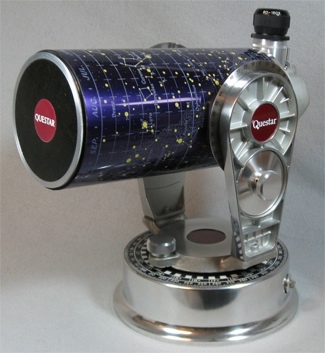Questar Distribution
![]() News
News ![]() Notes & Interesting Articles
Notes & Interesting Articles ![]() Overview
Overview ![]() Pricing
Pricing ![]() Products
Products ![]() Service or Repair
Service or Repair
Questar Telescopes ![]() LD Surveillance Systems
LD Surveillance Systems ![]() LD Microscopes
LD Microscopes ![]() Accessories
Accessories


Mid Production Questar Standard 3-½ Telescopes: Featuring SN 1043 from 1961
In this article we show Questar 3-½ Standard, Serial No. 1043. A telescope on display at our telescope museum collection.
This article is provided as a courtesy by Company Seven for those customers who have helped to keep us in business.
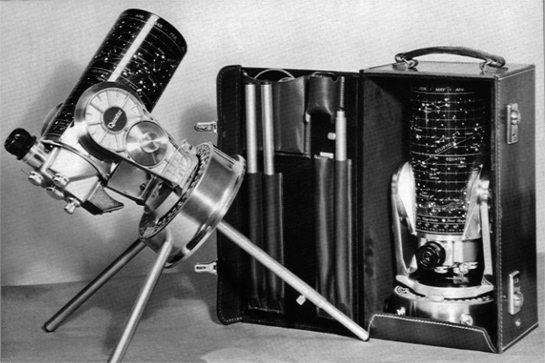
The American made Questar has since 1954 been acclaimed as an elegant and refined practical tool for astronomy: the Rolls-Royce of compact telescopes. The fundamental attributes attracting such praise remains the same today as it was: performance, convenience, and reliability. The Questar 3-½ is among the last of few products in production over the recent decades where no practical or aesthetic aspect has been compromised in order to cut costs. This arguably remains the best balance of essential attributes in the carry-on portable class of telescope - downright easy to set up and rewarding to use.
Right: a mid production model Questar of 1960 in Pole aligned mode at left, and cased at right (90,489 bytes). From the 1960 edition of the Questar booklet that is available for download at our Questar Notes & Interesting Articles on line archives.
Click on image to see enlarged view (329,005 bytes). Photo from Company Seven archives.
In this article we will look at one example of the Questar 3-½ telescopes made in the arrangement that we at Company Seven refer to as 'mid production'. These are telescope made from 1957 into the late 1960’s incorporating refinements that differentiate these from the first or early production telescopes. This will include changes of:
- the optical arrangement,
- the Control Box finish
- changed internal prism
- mechanical construction materials (by mid 1957 backplate is aluminum, etc.),
- how their provided accessories differed,
- and other improvements became standard or were made available as options.
As explained in our article How to Choose Your Questar 3-½:
-
"Aside from the quality of optics, the Questar telescopes include patented devices to insure these instruments are compact, free of periodic adjustments, and user-friendly. All of these features evolved before the now popular term "user friendly" was first uttered. These features include built-in magnification changers, an integral finderscope, extraordinarily smooth and precise focusing mechanics. All of this is may be duplicated at some cost in another telescope. However, what makes the astronomical Questar 3-½ models even more unique is their extreme portability: these are a complete personal portable and power independent tracking telescope, with six magnifications (three from each provided ocular), tabletop tripod legs, superb quality Solar Filter (one for the telescope objective, and one for the finder too) which can show an eclipse and reveal Sun spots and Faculae, all of which store under an average airline aircraft seat within a compact fitted case as shown above."
Over the first year and a half of production Questar production grew to average five or six units sold per month. Between 1956 and mid 1961 sales increased to average almost eighteen units per month. The number of new instruments delivered between commencing production in the first five years was doubled over the following two years. The increase of sales parallels the growing increase in space prompted by the early manned space flight missions, an increase in science education and awareness of Eclipse events, and the growing recognition that the Questar was a unique and valuable instrument.
Since its introduction Questar has been immortalized in film and in books by respected people including Johnny Carson a national television icon, and renaissance man Arthur C. Clarke who wrote "the finest small telescope ever built--the 3-½ inch Questar, a jewel of precision optics which has produced close-ups of the moon that could easily be mistaken for Mount Wilson photographs". Among three Standard Questar telescopes made for the US Army Redstone Arsenal in May 1959 was one that was used by Dr. Wernher Von Braun, this telescope remains in service with the Kennedy Space Center amateur astronomy club. These telescopes that inspired so many who in turn inspired us look just like the Questars described in this article.
The Questar is considered such a high accomplishment that a special 1965 Questar Standard 3-½ now resides in the collection of the Smithsonian Museum of Technology in Washington, D.C.; it is a unique cut-away instrument that reveals the various innovations unique to the Questar. These basic principles of the telescope remain unchanged, even after nearly sixty years in production.
A Mid Production Questar: a part of our mission is to promote science education through astronomy. In support of that mission Company Seven maintains a museum display of antique or otherwise interesting telescopes, associated equipment, and documents that will help to understand and appreciate the evolution of the hobby and its technologies. Among those items on display is the following Questar Standard telescope:
These telescopes incorporate a Primary Mirror made of Corning Pyrex®. The Primary and Secondary Mirrors were coated with reflective aluminum, then overcoated with Silicon Monoxide (AlSiO) a hard protective coating to prevent oxidation of the aluminum. The thick meniscus Corrector Lens of these telescopes is made of borosilicate crown glass. This lens and the optical elements housed in the Control Box are antireflection coated with Magnesium Fluoride (MgFl) to increase transmission by up to ninety eight percent per surface. By 1957 Questar customers would be offered the choice of either the standard Pyrex® Primary Mirror, or at extra cost the telescope could be made with a more thermally stable Quartz (fused silica) primary mirror substrate. The cost to upgrade to Quartz primary mirror substrate was $100; we are not sure it if was because Questar did not actively feature this in advertising until about 1965, of it it was the added cost, but the Quartz option did not really seem to take off in sales until 1963.
In 1967 Questar began to offer the optional Broadband Coatings group. The optional Broadband coatings consist of an enhanced protected silver film on the primary mirror, and a highly efficient antireflection coating applied to both sides of the corrector lens. This option improves throughput of the entire system by about twenty percent, a notable assist when observing the more subtle features on the planets, and for observing deep-sky objects within the reach of these telescopes. Over the first decade or so these were applied for Questar by the famous Perkin-Elmer Corporation, of Danbury, Connecticut. While the protective overcoating inhibits oxidation of the silvered mirrors, these first generations of Broadband could show signs of tarnishing in as little as ten years or so. The technology was improved so that by the late 1980’s and into the 1990’s the durability of the Broadband became almost a non-issue. It is a simple but costly matter to strip then coat the optics set should these coatings fail, but most who ordered this option have felt it worthwhile.
Beginning in 1967 Owens-Illinois Corning Cervit, a glass-ceramic material introduced that year, was offered as the more thermally stable mirror upgrade option for the Questar. Raw stocks of Cervit tended to be flawed by the inclusion of crystals and small bubbles (typically 0.1 to 0.2mm diameter) formed during the manufacturing process. These inclusions might not be found when making the mirror until the grinding process was well under way, hence there was a notable rejection rate of mirror stock at the company making these optics sets for Questar. In 1968 the Carl Zeiss subsidiary Schott AG had developed Zerodur, this is a more consistent ceramic substrate. Even though Zerodur had been introduced about the same time as Cervit, the mentality at Questar was to, as much as is practical, to make the telescope entirely in the U.S.A., and so Cervit continued to be the optional substrate. However, in 1978 the manufacture of Cervit was discontinued by Corning and so by 1980 as stocks became depleted Questar switched over from offering Cervit as their optional substrate to Zerodur. Most clients ordering the Cervit option tended to also have their telescope optics manufactured with the higher throughput Broadband Coatings option too, but this was not necessarily a paired group mandated by the factory until well into the 1980’s to streamline production.
The Fork Mount and Base assembly supports the telescope optical tube assembly rigidly, and allows the user to point the telescope up or down in altitude or in astronomical terms 'Declination' motion. The motion is smooth and is controlled by a manual friction drive control knob on the side of the fork. The fork mount base also permits the assembly to be rotated left or right by means of the manual friction drive control knob on the top of the fork base.
As the Earth rotates about its axis the celestial objects overhead appear to move across the sky from east to west, this is an arcing motion referred to in astronomy as Right Ascension. The Questar Fork Mount and Base assembly supports the telescope rigidly, and their clutched mechanisms allow the user to grasp the telescope optical tube and point it up or down in altitude, or in astronomical terms 'Declination' motion, or left and right in 'Right Ascension'. The motions are smooth, the Declination motion can be finely controlled by rotating the manual friction drive control knob on the side of the fork. The fork Base also permits the optical tube assembly to be rotated in Right Ascension by means of the manual friction drive control knob off center on the top of the fork base.
The Base of Questar 3-½ telescopes, and later the Questar 7, were manufactured over the first few decades incorporating an AC powered synchronous motor. The motorized drive provides when the telescope mount is Pole Aligned parallel to the Earth’s axis of rotation, the mount will drive the telescope to track celestial objects at a Sidereal rate; this is moving one full rotation in 23 hours 56 minutes and 4 seconds. The drive Base incorporates a A.C. (120 Volt or 220 volt optional) motor with a two prong male socket built into the bottom cover plate of the Base. The 2 watt motor (2.7 on later models) is ½ RPH with a sealed and lubricated gear train, these were originally sourced by Questar from Cramer Controls Corp. in Centerbrook, Connecticut. Since the rotation of the motor is not reversible, Questar provided a motor with the correct voltage and rotation to be used at the customers location either in the North or the Southern Hemisphere. For those traveling to another hemisphere the appropriate motor could be ordered and then installed with simple mechanical skills.
Most AC wall receptacle and power cords in the United States of this era are a two slot socket and plug arrangement. Both of the receptacle slots and both plug blade tips too are identical in width and thickness, so a power cord can be plugged into a receptacle in either orientation right side up or upside down. The Questar was originally provided with a brown insulated, 7 amp rated AC power cord with a two prong male plug on one end, at the other is a female socket with two identical 3/32 inch (2.23mm) diameter prong holes spaced 3/10 inch (7.42mm) center to center. There is a specific flow of how the AC current runs through the wiring. One of the plug blades connects to the neutral wire socket of a receptacle, while the other blade connects to the hot wire. The hot wire carries electricity into the home and to the breaker panel, while the neutral wire carries unused electricity back to the breaker panel and out. To provide an added measure of safety for these lighter duty appliances the polarized plug and socket were developed. Questar adapted, so the later power cord and socket are polarized with tips being 7.2mm center to center with a larger 3.5mm and smaller 2.5mm prong holes and this can be retrofitted to older Questar telescopes. In fact today Questar Corp. will provide only the polarized AC cord as a replacement part, this can be sold with a new matching polarized plug socket to replace the original in the Base.
The provided tabletop tripod is an arrangement consisting of two fixed length legs that slide into the holes along the side of the Base casting, plus one adjustable length leg which slides into the orifice center of the Fork Mount Base. In order to align the axis of rotation of the mount with that of the Earth, one tilts the fork mount atop the tripod so that the center leg parallels the Earth’s axis of rotation and the imaginary line running through the center of the leg and up through the fork mount points to the Celestial Pole. To Pole align the mount the assembly is pivoted left or right to point the fork towards the Pole, while the length of the Center leg is adjustable from between 10-5/8 to 18-11/16 inches to permit the user to adjust the tilt of the Fork Mount and Base. Each leg has a protective non-marring and non-slip black rubber tip so that it will not mar a tabletop. For the Questar astronomical telescopes made through the late 1960’s both fixed length legs slip into the Base casting, while the center leg slides into an orifice in the bottom of the Base.
The two tripod leg ports on the side of the Base casting are each provided with a removable gasketed plug. These plugs each consist of three parts: the plug with gasket and a bolt so that when the telescope is set up on the provided tripod legs set the plugs can be pulled off the hole then stored into threaded sockets in the bottom of the Base. On early production Questar telescopes the bolt was blued, then in 1956 the production transitioned to stainless steel. In 1975 as larger diameter thread-in legs were provided, the plug became a simpler gasketed aluminum disc.
When properly Pole aligned and tracking then the mount’s tracking motion counters the apparent motion as Earth rotates about its axis so that these objects appear motionless and suspended in space at the eyepiece. The Questar can keep the objects in the field of view of an eyepiece or camera thereby removing the distraction and difficulty of manually trying to follow objects precisely across the sky. The tracking feature also facilitates sharing the telescope with young or inexperienced observers. The manual and mechanical mechanisms are friction drives so there is no periodic error (as there will be with worm gear drives) and this facilitates employing the telescope for astrophotography.
With the provided functional Moon Map and Star Chart on the telescope barrel and Dew Shield, and by using the Declination and Right Ascension setting circles the user of the Questar can learn much about celestial navigation, and how to find the otherwise unobservable objects that might otherwise go unnoticed. These early charts incorporated features to make the more readable in low light including embossing and texturing so that the major features into the metal covering. This manufacturing technique would be discontinued by the late 1960’s when the charts became silk screened. The original style embossed charts would be brought back as a feature of the deluxe 50th Anniversary Model telescopes released in September 2000.
The Declination Setting Circle is made of machined steel stock, with the degree numbers and hash mark increments engraved and painted black. The Declination Setting Circle is provided on the left side of the fork mount, the circle on the right side is a component of the elevation friction drive.
The distinctive flared cylindrical base is cast from corrosion resistant aircraft grade virgin aluminum 356-T6 heat treated alloy then is hand turned, then machined. As 356 alloy will not color anodize this is hand polished to a pewter sheen, over time the natural metal finish can be renewed simply by polishing. The 5/8 inch (15.75 mm) diameter tripod legs are made of lightweight Aluminum 61 S-T3, each is centerless-ground to a tolerance of 0.0001 inch then anodized.
The tripod hole plugs in the Base of Questar telescopes made from 1954 to the late 1960’s served two functions, one as hole plugs and the other as attachment screws for hanging the telescope onto a suitable panel such as a half open car window. This is a most precarious looking arrangement, but one that worked for some people for terrestrial observing. The rotating capability of the barrel allows the eyepiece to be rotated to away from the car to facilitate access. This is pictured on page 7 of the 1960 edition Questar booklet available for download at our Questar Notes & Interesting Articles on line archives.
Right: left rear view of 1961 Questar Standard 3-½ in Company Seven’s Museum Collection (72,030 bytes).
The controls and components are:
The Finder in the telescope consists of a 3/32 inch thick elliptical pick off mirror attached onto a 45 degree inclined support brace, this assembly is attached to the bottom of the Control Box. Light comes from the distance into the mirror then is deflected up and through the Finder Objective Lens located at the bottom of the Control Box. The light is focused by this lens into the area of the eyepiece Field Stop.
The early and mid production Questar telescope eyepieces are a two piece threaded assembly. The lower section threads onto the cylindrical eyepiece holder, while the eyepiece upper section (housing the optics) rides on a thread so this section can be rotated up or down to reach focus when observing through the Finder.
2. An Amici image erecting prism was built into the Control Box of the early Questar telescopes made from May 1954 to May 1959. To improve resolution a change starting in June 1959 the Amici was replaced in production by a Star Diagonal prism. When the Finder/Telescope selection dial is rotated counterclockwise so that the lever points up, then the prism slides into place at the center inside the Control Box so that when light comes out of the telescope’s main optical tube into the Control Box the prism diverts the image so that it will appear at the eyepiece. The Star Diagonal prism corrects the image orientation so that it will appear right side up but reversed left to right.
3. Also built-in to the Control Box is a magnifying (Barlow) negative lens. This can be dialed in or out by the topmost knob on the Control Box; rotate the control knob counterclockwise to move the Barlow lens off line, or clockwise to engage the Barlow when observing through the main telescope.
The Barlow is incompatible with the Finder operation, eyepieces will not reach focus with the Finder while the Barlow is engaged. Furthermore, the Barlow is intended to help attain higher magnifications (these can vary but tended to be about 1.8x then) with the two eyepieces then provided; this will not fully illuminate the field stop of most lower magnification eyepieces that came available years later.
4. The precision focus control of the main optics is an internal arrangement where the Primary Mirror is supported by a spring-loaded thimble, this assembly moves forward and back along the Primary Baffle Tube within the telescope, thus there is no change of physical length when focusing.
By 1955 the focus arrangement and knob location had been changed to what we are used to seeing since, with the knob below and to the right of the Axial Port. Dialing the focus knob clockwise moves toward infinity and beyond, while dialing counterclockwise moves to focus onto objects closer and closer to the telescope.
The precision machined focus knob evolved in 1961 to the button style knob, this replaced the older style longer cylinder-shaped knob of 1954 and the similar 1955 to 1960 knob. The shorter form remains in production to this day. You can see the two more common styles of knob that were most produced in the photo of the two Questar telescopes below. Questar telescopes are hand assembled and also are serviced from the parts then available in inventory and so it is possible to find an older component, that does not detract from performance, installed on a Questar made sometime later; so you may find a 1961 Questar with the 1950’s style knob for example.
5. Thread on eyepiece adapter tube at the top of the Control Box. The two eyepieces provided with telescopes made from 1954 through 1972 feature a threaded rotating top barrel, this can be turned clockwise or counterclockwise to focus the eyepiece when looking through the telescope Finder. These older eyepieces also differ from modern Questar Brandon eyepieces, introduced in 1972, in that their attachment thread is narrower and not interchangeable with the eyepiece holder of modern eyepieces.
6. The Axial Port is the large female threaded opening at center of the Control Box. This accepts optional hardware including the Swivel Coupling Camera Adapter, Drop-in Filter Holder, and more. With the telescope set to Finder mode the light will pass from the main telescope tube and to the Axial Port, with the cap removed the light will continue out to an optional camera or other device.
On those Questars made from 1954 to 1972 this port is 0.95 inch diameter, some transition models and all later production telescopes will have 1.2 inch diameter ports for better performance when imaging and with some other optional accessories. We do offer adapters to permit the use of newer accessories onto the early Questar telescopes, although there may be vignetting of some modern accessories. It is possible to retrofit a new Control Box casting with the larger Axial Port, to an older Questar.
The Control Box casting of the Questars is made of an aluminum-silicon alloy, this inherently provides good corrosion resistance. And the expansion coefficients even at subzero temperatures are some ten to twenty percent lower than those of pure aluminum. The focus knob, dials and Axial Port cover are machined from aluminum 24S-T4 that is a heat treated corrosion resistant alloy, the dials feature stainless steel levers. These parts too are hand-turned on a turret lathe.
Above: early (1955) and mid (1961) production Questar telescopes displayed at Company Seven (171,261 bytes).
Mid Production Models: the design focal length of the early production Questar optical system was nominally 1,070 mm (42.1") f/12. By 1958 the mid production telescopes were 1,077 mm (42.4") f/12.1. By 1960 the telescopes would be 1,156 mm (45.5") f/13, then by the late 1960’s the design would be settled into the later production 1,280 mm (50.4") f/14.4 design that remains in production on current models.
The telescopes made between 1954 and early 1956 are easy to distinguish from the 1956 to mid 1960’s production telescopes because of the red, silver and blue "Questar" declination axis cover plates. These are affixed to either side of the Fork Mount arms with contact cement. The plates read "4.2" APOCHROMAT F:12", Questar, NEW HOPE PA•U•S•A•" (yes there was a time when tangible items were made in the USA). These early discs are glued onto the top ridge of the cast circle on the Fork Tine thus it is more likely to snag or be knocked off than the later example where the disc is glued in but recessed below the ridge level of the casting, so the mid and later production telescopes are less likely not to have lost their Fork bearing cover disc accidentally.
Looking for the three color pattern or for the star on the Fork Arms Declination axis bearing covers of an older Questar is not always a reliable way to judge the age of the telescope since during the course of routine use and transport or during servicing visits these original disc could be pried off and replaced by later versions. Close inspection of the cover in the image above center shows signs that someone pried this cover thereby marring the edge, this likely happened during servicing. Over the recent years we have become more careful to preserve the historic integrity of older Questars by employing time consuming methods to remove the covers but without damaging them so that the originals can be attached into place after the servicing.
left: Questar telescopes barrels are made from forged aluminum shells on the engine lathe. Here experienced craftsman Ernie Arndt is working on a barrel in the mechanical assembly area. Image from a Questar magazine ad of 1962 (66,856 bytes).
The Finder Solar Filter mechanism became standard equipment for Questar Standard and Duplex telescopes produced since early in 1967. This is a hinged assembly fitted over the Finder Lens at the base of the Control Box, designed so that the user can swing the filter element ninety degrees up and over the Finder lens, between the pick–off mirror and the lens. Having this in place completely eliminates the risk of a user accidentally selecting from viewing through the main telescope with it’s Solar Filter attached to the Finder mode that up the then had no solar filter protection. This accessory also helps to keep the interior of the Control Box dark, free of glare from sunlight that could otherwise enter through the Finder Lens. To this day no other manufacturer has been so thoughtful to provide such a convenience built-in to their telescope!
The Questar Finder Solar Filter remains a retrofittable option that is available for the older Questar telescopes. However, some older Questar telescopes incorporate a pick–off mirror that is thicker than those mirrors installed before the Finder Solar Filter was developed. So those instruments that do incorporate the thicker Finder mirror will lack the swing–through clearance needed by the hinged Finder Solar Filter mechanism. Instruments with the thicker mirror require replacement of their pick–off mirror to accommodate the Finder Solar Filter assembly. Also note, since this could have been retrofitted to an earlier Questar the presence of this accessory alone does not it itself help to date the age of the telescope.
The knurled hand knobs attached onto either side of the Fork Mount control the elevation lock and elevation motion fine control. The knobs of Questar mid and current production telescopes are machined from solid stock, attached by a bolt threaded from the inner side of the fork.
The Control Box casting of the Questars made since early 1956 are hand sanded, primed, then painted silver. You can see the differences between the early production unfinished castings and those of mid and later production telescopes in the image above of the 1955 telescope alongside a 1961 Questar.
In time Questar discovered the threads tapped into the Synthane backplate wear out from the friction of the honed stainless steel threaded shaft. The wear progresses so that mirror shift while focusing becomes more and more pronounced, the smoothness of focusing degrades, and eventually the threads wear out altogether so the user can not focus until the back plate is replaced. So Questar gradually moved away from using Synthane and instead relied on machined aluminum for these components. Over the years of the mid production telescopes the front cell, the rear wall and Base covers were changed over to aluminum.
The accessories provided as standard with this mid production telescope for $995 included:
1. 40-80X Eyepiece
For models made from 1957 to the present day have information the telescope Serial Number engraved onto the cover at the bottom of the Base. This engraving is usually located between the center opening for the tripod leg and the AC wall plug socket.
Into 1956 the early Questars were shipped in a protective Leather Carrying Case (described below) but with no Lens Cover since it was assumed the case could provide satisfactory protection of the Corrector lens. Questar changed the design of the optical tube front cell on mid to current production telescopes so that the 95 mm diameter radius is threaded to accept a new lens cover or the provided revised Solar Filter. Questar simultaneously devised a thread on Lens Cover to protect the Corrector Lens of the telescope. The lens cover was made with the black disc made of the lightweight Synthane material with a lightweight aluminum alloy edge trim glued onto the Synthane. The center is covered with a Questar logo disc glued into place.
The fork tines of early to mid production Questar telescopes feature gloss reflective polished edges with the recessed areas on the face of the fork tines painted silver. By the mid 1980’s the quality of the castings being provided caused the company to change from polished edges to a fine vertical milling that leaves a satin appearance.
As mentioned above, the early production Questars like this one also have an etched and white filled Moon Map, Star Chart, and with a Right Ascension Setting Circle instead of the silk screened versions produced for later production units.
Eyepieces and Magnifications: these telescopes were engineered to accept either of two provided eyepieces, each is an assembly with a male thread of 1.175 inch (29.85 mm) diameter. The knurled upper assembly of the eyepiece houses the optical elements and the eyepiece Field Stop. The eyepiece threads onto the telescope eyepiece holder atop the Control Box. One dials the two Control Box knobs to allow the eyepiece to view through the Finder, then rotates the knurled upper assembly clockwise or counterclockwise to bring the Field Stop closer to or farther from the Finder’s objective lens until focus the object of study is sharp and clear.
The two eyepieces provided with new Questar telescopes produced from 1954 through mid 1973 are:
1. 40X a 26mm König lens design with a 50 degree apparent field of view (measured by Company Seven as having a 18mm Dia. Field Stop), and
2. 80X a 12mm Erfle a five element wide angle lens claiming a 75 degree apparent field of view (16.6 mm Dia. Field Stop).
Those eyepieces provided with the Questar telescopes delivered from 1954 through 1973 were made by Toyo Jitsugyo KK, an optical company established in 1947 in Japan. Those made prior to 1956 bear no markings to indicate maker, or country of origin. The eyepieces made from 1956 will bear the engraved code mark "B.O.L. JAPAN"; this refers to an arrangement the manufacturer established between Oriental Trading, the export division of Toyo Jitsugyo KK., with Bushnell Optical Laboratory Inc. then based in California. These eyepiece do not bear the diopter indicators of the original eyepieces, the barrels of these eyepieces are finished plainly in black paint.
The eyepiece could have been provided from the factory with the option a crosshair reticle ('+') pattern spanning edge to edge) installed. The black cross-hair is and glass thread on or off, positioned in place of the field stop.
The early Questar 3-½ telescopes were equipped with eyepieces to reach magnifications of up to 160x, though they are capable of higher. The optical design of these original telescopes and some other factors too produced a system that is good; under a critical star test a well adjusted early Questar can show a nice diffraction pattern since the optics shop making the optics then (as now) hand matched each set of optics to assure nominal figuring. Late in the 1960’s the design of the optics was changed, overall specifications made more stringent, and improved materials and coatings offered. These changes along with new choices of eyepieces would provide the later production telescopes with truly amazing higher magnifications and brighter performance.
The case is designed to hold the Questar telescope with all its standard accessories. The accessories provided with the telescope are stored in leather pouches sewn onto the interior of the door lid. This arrangement is illustrated by the image at the bottom right of this article.
Right: Original Questar Leather Case in Company Seven’s Museum Collection (74,161 bytes).
The case is laid out well and is compact, light weight (especially compared to modern Questar cases), and is beautiful. There are some aspects that are unusual:
The door lid is secured by two nickel plated steel spring loaded keyed laches, each cases included two keys. The lock hardware was made by C.W. Cheney And Son Ltd., a famous maker of locks, keys, hinges, and other hardware. Cheney was established soon after World War I, based on Factory Road in Hockley, England but has since been acquired by other companies, moved from Factory Road after 2001, and little remains with the qualities of what they made in the era of the Questar cases. Do keep in mind these locks only serve to keep the honest person honest; anyone who really wants to get in can handily walk off with the Questar in the case and force these latches to the breaking point.
Right: typical carrying case interior arrangement with standard accessories: Solar Filter, Aperture Stop, the shorter Eyepiece is installed, the longer Syepiece stores in case lid pouch, AC Power Cord (wrapped as provided), Tabletop Tripod Leg set. The keys and a spline wrench are in the pouch (84,199 bytes). Telescope is shown at Company Seven’s Museum Collection.
Basic Configuration: the production 3-½ astronomical telescopes of the 1950’s and today consist of a Maksutov-Cassegrain optical tube assembly mated to a dual tine fork mount and base. As shown to the right in the image at the top of this page, the astronomical Questar 3-½ telescopes are provided with a lightweight but rigid tripod so the mount can be Pole aligned and the drive will track celestial objects as they appear to move across the sky. The mount also incorporates features to help one learn and navigate the night sky.
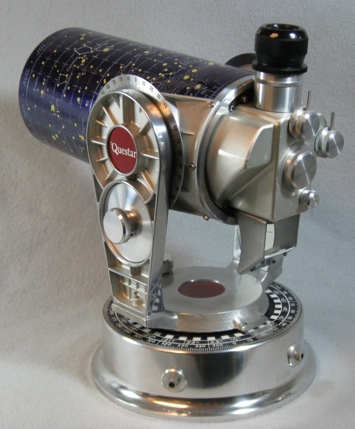
Control Box: the Questar patented Control Box at the rear of the optical tube assembly is among the distinguishing features of the Questar. This housing incorporates a series of control dials, linkages and optical components that make the Questar easy and convenient to use.
Click on image to see enlarged view (197,592 bytes).
1. The Finder/Telescope selection knob is set to divert light from either the Finder or the main optics of the telescope up to the eyepiece. This knob is the one to the right of the axial port at the rear of the Control Box. When the knob is dialed out (clockwise) this permits the user to observe through the Finder, or dialed counterclockwise to observe through the telescope.
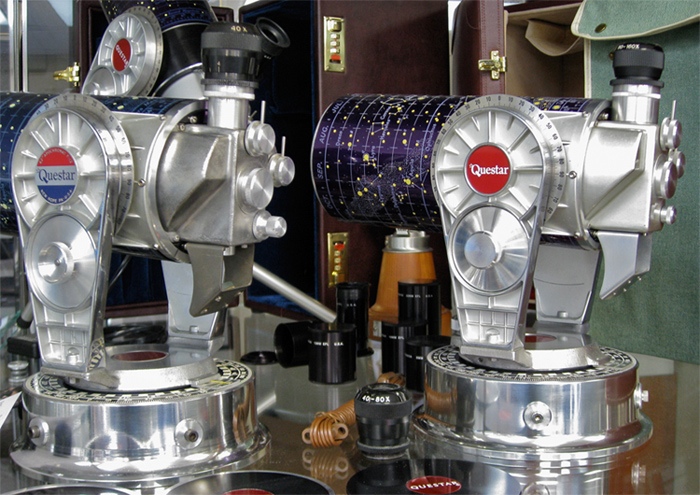
Click on images to see enlarged views (325,640 bytes).
Above left: Fork Arms Declination axis bearing cover disc provided on instruments made from 1954 to early 1956 (30,306 bytes).
Center Left: Cover provided recessed over the Fork Base bearing from 1956 to 1963 (83,529 bytes).
Center Right: Cover provided over the Fork Base bearing from 1963 to 1980 (83,529 bytes).
Right: Cover provided for models made since 1980’s with the ® symbol (24,058 bytes).
Click on image to see enlarged view (134,067 bytes).
 These early and mid production Questar telescopes incorporate some components made of Synthane, a dimensionally stable and lightweight Bakelite tube made by the Synthane Corporation. Synthane sheets consist of a laminate of fibrous sheet materials such as cellulose or asbestos paper, or a cotton or asbestos or glass fabric, saturated with a thermo setting resin. This is cured over time under high temperature and pressure. These components made with Synthane were gradually transitioned to machined aluminum stock but originally included the Corrector Lens front cell, the optical tube assembly backplate (the wall between the Control Box and Primary Mirror), and the cover at the bottom of the Base.
These early and mid production Questar telescopes incorporate some components made of Synthane, a dimensionally stable and lightweight Bakelite tube made by the Synthane Corporation. Synthane sheets consist of a laminate of fibrous sheet materials such as cellulose or asbestos paper, or a cotton or asbestos or glass fabric, saturated with a thermo setting resin. This is cured over time under high temperature and pressure. These components made with Synthane were gradually transitioned to machined aluminum stock but originally included the Corrector Lens front cell, the optical tube assembly backplate (the wall between the Control Box and Primary Mirror), and the cover at the bottom of the Base.
2. 80-160X Eyepiece
3. Velvet-lined English cowhide Carrying Case with two keys
4. Questar Tabletop Equatorial Tripod Legs
5. Questar AC Power Cord
6. Questar Off-Axis Solar Filter
7. Questar Front Lens Diaphragm
8. Questar Bristol Wrench
9. Questar Booklet
10. Questar Owners Manuals
11. A letter of gratitude usually signed by Lawrence Braymer, the founder of Questar
12. Leverpak shipping drum.
The Questar telescopes delivered well into 1957 were provided with eyepieces labeled simply "40X" and "80X". The Questar telescope eyepieces provided from later in 1957 through to 1973 are labeled "40-80X" or "80-160X" to make it more clear these can be used with the Barlow Lens dialed in line or out. Of course it is possible that owners bought used older eyepieces to replace lost newer ones or vice versa, so eyepiece labeling alone cannot be counted on to date a Questar.
* the Barlow lens built into the Control Box of the telescope was represented as providing an amplification factor of about 2X*. Over decades of acceptance testing new and older Questars at Company Seven, we find the effective Barlow magnification could vary higher or lower than 2X from production lot to lot.
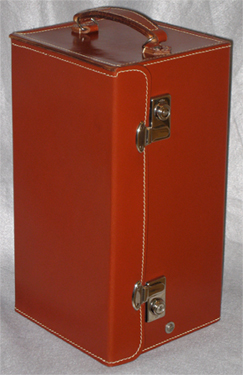 English Leather Case For Questar 3-½: among the accessories that distinguished the Questar was the custom fitted rigid case provided as a standard accessory with each new astronomical telescope. The Questar telescope slides into the larger portion of the case, while the door interior has pouches sewn in to accommodate those accessories that were provided with the Questar. The case is made in England of two ply stitched Saddle Leather, with the interior fully lined in velvet. The leather is pliable and without any additional interior bracing, yet it is rigid enough to retain its shape and hold the seven pound Questar 3-½ safely in transit. The Questar literature of the period describes the provided case as:
English Leather Case For Questar 3-½: among the accessories that distinguished the Questar was the custom fitted rigid case provided as a standard accessory with each new astronomical telescope. The Questar telescope slides into the larger portion of the case, while the door interior has pouches sewn in to accommodate those accessories that were provided with the Questar. The case is made in England of two ply stitched Saddle Leather, with the interior fully lined in velvet. The leather is pliable and without any additional interior bracing, yet it is rigid enough to retain its shape and hold the seven pound Questar 3-½ safely in transit. The Questar literature of the period describes the provided case as:
"FINEST BRITISH COWHIDE, each one made by hand for us in Staffordshire, England. Deep luggage tan color, fully velvet lined in old wine color, leather pouches for accessories. Conservative white stitching, two locks. Rim of Questar’s base held in case by adjustable eccentric Synthane disks."
Click on image to see enlarged view (236,042 bytes).
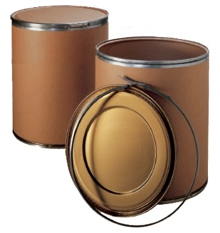 Leverpak Shipping Drum: since 1954 the Questar telescopes have been shipped from New Hope, PA safely packaged within it’s provided carrying case and this within an outer packing drum. The drum design was patented by Leverpak in the 1930’s and it continues in production to this date with little obvious changes. The 16 inch diameter x 22 inch tall (17-½ gallon capacity) drum features a surprisingly low tare weight combined with high payload and weight bearing capacity, and a steel top and band with lever locking mechanism. The unique Lok-Rim® closure allows easy opening and closing and has a tamper evident sealing feature.
Leverpak Shipping Drum: since 1954 the Questar telescopes have been shipped from New Hope, PA safely packaged within it’s provided carrying case and this within an outer packing drum. The drum design was patented by Leverpak in the 1930’s and it continues in production to this date with little obvious changes. The 16 inch diameter x 22 inch tall (17-½ gallon capacity) drum features a surprisingly low tare weight combined with high payload and weight bearing capacity, and a steel top and band with lever locking mechanism. The unique Lok-Rim® closure allows easy opening and closing and has a tamper evident sealing feature.

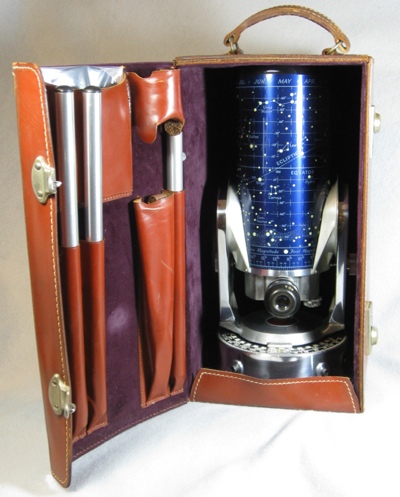 Questar Telescope Specifications 1961
Questar Telescope Specifications 1961
Telescope Clear Aperture
3.54 inch / 88.9 mm
Effective Focal Length
50.39 inch / 1280 mm
Barlow Amplification
1.7x
Telescope weight (w/eyepiece, Lens Cover)
6 lb. 15.5 oz. / 3.162 kg.
Tabletop tripod leg set weight
6.0 oz. / 168 g
Carrying Case Dimensions
7-½ inches deep x 7-¾ wide x 14-½ tall
190 x 210 x 368 mm
Origin
Made in the USA
Click on image to see enlarged view (273,866 bytes).
We invite you to visit our showroom near Washington, D.C. to see a Questar first hand or contact us by E-mail to info@company7.com, or by telephone 301-953-2000. The showroom is open Monday to Friday 11 am to 6 pm, Saturday 11 am to 5 pm. We are closed on Sundays, on U.S. Holidays, and from 25 December through 1 January inclusive.
![]()
Contents Copyright 1954-2023 Company Seven, All Rights Reserved


